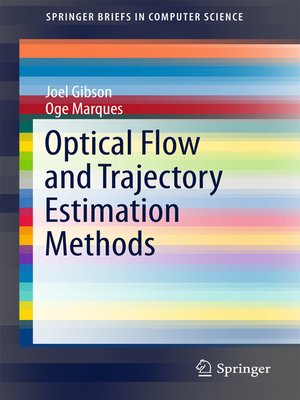Optical Flow and Trajectory Estimation Methods
ebook ∣ SpringerBriefs in Computer Science
By Joel Gibson

Sign up to save your library
With an OverDrive account, you can save your favorite libraries for at-a-glance information about availability. Find out more about OverDrive accounts.
Find this title in Libby, the library reading app by OverDrive.



Search for a digital library with this title
Title found at these libraries:
| Library Name | Distance |
|---|---|
| Loading... |
This brief focuses on two main problems in the domain of optical flow and trajectory estimation: (i) The problem of finding convex optimization methods to apply sparsity to optical flow; and (ii) The problem of how to extend sparsity to improve trajectories in a computationally tractable way.
Beginning with a review of optical flow fundamentals, it discusses the commonly used flow estimation strategies and the advantages or shortcomings of each. The brief also introduces the concepts associated with sparsity including dictionaries and low rank matrices. Next, it provides context for optical flow and trajectory methods including algorithms, data sets, and performance measurement. The second half of the brief covers sparse regularization of total variation optical flow and robust low rank trajectories. The authors describe a new approach that uses partially-overlapping patches to accelerate the calculation and is implemented in a coarse-to-fine strategy. Experimental results show that combining total variation and a sparse constraint from a learned dictionary is more effective than employing total variation alone.
The brief is targeted at researchers and practitioners in the fields of engineering and computer science. It caters particularly to new researchers looking for cutting edge topics in optical flow as well as veterans of optical flow wishing to learn of the latest advances in multi-frame methods.
Beginning with a review of optical flow fundamentals, it discusses the commonly used flow estimation strategies and the advantages or shortcomings of each. The brief also introduces the concepts associated with sparsity including dictionaries and low rank matrices. Next, it provides context for optical flow and trajectory methods including algorithms, data sets, and performance measurement. The second half of the brief covers sparse regularization of total variation optical flow and robust low rank trajectories. The authors describe a new approach that uses partially-overlapping patches to accelerate the calculation and is implemented in a coarse-to-fine strategy. Experimental results show that combining total variation and a sparse constraint from a learned dictionary is more effective than employing total variation alone.
The brief is targeted at researchers and practitioners in the fields of engineering and computer science. It caters particularly to new researchers looking for cutting edge topics in optical flow as well as veterans of optical flow wishing to learn of the latest advances in multi-frame methods.







